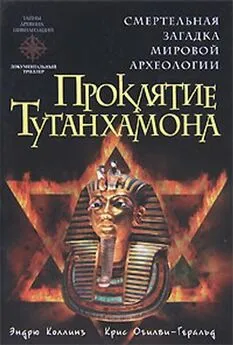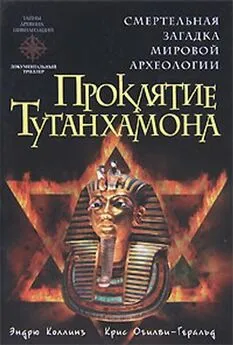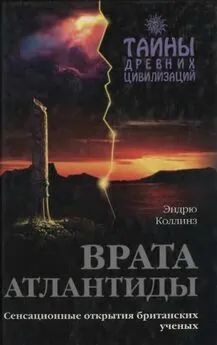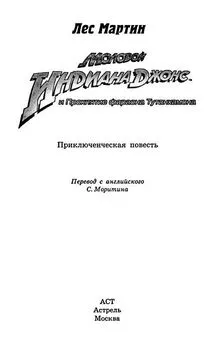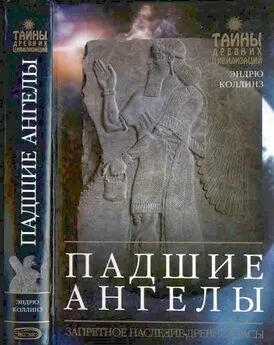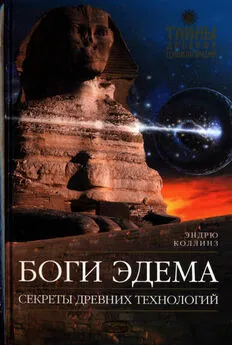Эндрю Коллинз - Проклятие Тутанхамона
- Название:Проклятие Тутанхамона
- Автор:
- Жанр:
- Издательство:М.: Эксмо, 2010. — 544 с.: ил
- Год:2010
- ISBN:978-5-699-41545-8
- Рейтинг:
- Избранное:Добавить в избранное
-
Отзывы:
-
Ваша оценка:
Эндрю Коллинз - Проклятие Тутанхамона краткое содержание
В своей увлекательной книге известные исследователи исторических аномалий Коллинз и Огилви-Геральд подробно изложили хронологию открытия гробницы Тутанхамона и связанных с этим загадочных событий Основываясь на письмах и статьях знаменитых археологов, а также воспоминаниях очевидцев, авторы задаются сенсационным вопросом: не могли ли Говард Картер и лорд Карнарвон обнаружить в гробнице Тутанхамона некую взрывоопасную тайну, способную в случае огласки перевернуть сложившиеся взгляды на библейскую и мировую историю? И не могла ли эта тайна стать для первооткрывателей усыпальницы реальным проклятием — осуществляемым не мстительными богами Египта, а наемными убийцами на службе влиятельных политических сил, которым могла помешать неудобная правда?
Проклятие Тутанхамона - читать онлайн бесплатно полную версию (весь текст целиком)
Интервал:
Закладка:
2 Weigall, Tutankhamen And Other Essays, p. 100.
468
3 Ibid., pp. 101—2.
469
4 See Manetho, trans., Waddell, p. xiv.
470
5 Weigall, p. 107.
471
6 Manetho, Aegyptiaca, quoted in Josephus, Flavius Josephus Against Apion, trans. Whiston, I, 26.
472
7 Ibid.
473
8 Ibid.
474
9 Ibid.
475
10 Ibid.
476
11 Ibid.
477
12 Ibid.
478
13 Manetho, trans. Waddell, fr. 54,1. 237.
479
14 Manetho, trans. Whiston, I, 26.
480
15 Ibid., Osarsiph, or Osarseph in Manetho, trans. Waddell, fr. 54,1. 238.3.
481
16 Manetho, trans. Whiston, I, 26.
482
17 Ibid. I, 14.
483
18 Manetho, trans. Waddell, fr. 54,1. 246.
484
19 Manetho, trans. Whiston, I, 26.
485
20 Ibid.
486
21 Ibid. It is «grandfather Rapses» in Manetho, trans. Waddell, fr. 54,1. 245.
487
22 Manetho, trans. Whiston, I, 27.
488
23 Weigall, pp. 108-9.
489
24 Ibid., p. 109.
490
25 Ibid., p. 110.
491
26 Ibid., p. 111.
492
27 Ibid.
493
28 Ibid., p. 112.
494
29 Ibid.
495
30 See Greenberg, The Hab/piru, and Na» aman, «Habiru and Hebrews: the transfer of a social term to the literary sphere», JNES 45: 4 (1986), pp. 271—88; Rowton, «Dimorphic structure and the problem of the «Apiru-«Ibrim», JNES 35:1 (1976), pp. 13–20.
496
31 Weigall, pp. 115-6.
497
32 See Meyer, Geschichte des Altertums, ii, pp. 421, 424-5, and Meyer, Aegyptische Chronologie, pp. 92—5.
498
33 Budge, Tutankhamen, Amenism, Atenism and Egyptian Monotheism etc., p. xiii.
499
34 Freud, Moses and Monotheism, pp. 97—8.
500
35 Ibid., p, 42.
501
36 Ex. 12: 12.
502
37 Weigall,p. 111.
503
38 Hecataeus of Abdera, quoted in Diodorus Siculus, Bib-liotheca Historica, 40, 1–8.
504
39 Ibid., 40, 1.
505
40 Ibid., 40, 3.
506
41 Apion, Aegyptiaca, quoted in Josephus, II, 2.
507
42 Redford, Akhenaten: the Heretic King p. 152.
508
43 Weigall, p. 110.
509
44 Budge, Gods of the Egyptians, I, p. 471; II, p. 361.
510
45 Aldred, Akhenaten — King of Egypt, pp. 43, 260;
511
46 Redford, pp. 146—7.
512
47 Aldred, pp. 87, 273.
513
48 Apion, in Josephus, II, 2
514
1 Manetho, Aegyptiaca, quoted in Josephus, «Flavius Josephus Against Apion», trans. Whiston, I, 26.
515
2 Ibid.
516
3 Ibid.
517
4 Ibid.
518
5 Redford, Pharaonic King-Lists, Annals and Day-books, 1986, p. 293.
519
6 Assmann, Moses the Egyptian: The Memory of Egypt in Western Monotheism, p. 39.
520
7 For an extensive discussion on the relationship between the Hyksos, the Thera eruption and the Tempest Stela see Chapter 16, Note 49- See also Redford, Egypt, Canaan, and Israel in Ancient Times, 1992, pp. 419—20.
521
8 Aldred, Akhenaten: King of Egypt, pp. 173—4.
522
9 Ibid., p. 174.
523
10 Pendlebury, «Summary report on the excavations at Tell el-«Amarnah 1935–1936», JEA 22 (1936), p. 198.
524
11 Ibid.
525
12 See Pendlebury, pp. 197—8.
526
13 Aldred, p. 174.
527
14 Pendlebury, p. 198.
528
15 Aldred, p. 180.
529
16 See, for example, Reeves, Akhenaten; Egypt's False Prophet, pp. 75–78.
530
17 Assmann, p. 26.
531
18 See Pausanias, Description of Greece, 1,42.
532
19 Aldred, p. 164.
533
20 Mahdy, Tutankhamun: The Life and Death of a Boy King p. 175.
534
21 Manetho, trans. Whiston, I, 26.
535
22 Aldred, p. 164.
536
23 Manetho, trans. Whiston, I, 26.
537
24 Manetho, trans. Waddell, fr. 54,1. 232.
538
25 Ibid., fr. 50, 1. 96, from Josephus, Contra Apionem, who gives the reign of Orus as 36 years 5 months; fr. 51, from Theophilus, Ad Autolyc. iii. 19, who gives 36 years 5 months; fr. 52, from Syncellus, according to Africanus, who gives 37 years; fr. 53 (a), from Syncellus, according to Eusebius, who gives 36 years (38 years in another copy); 53 (b) Armenian version of Eusebius, which gives 28 years.
539
26 Ibid., fr. 50, 1. 96, from Josephus, Contra Apionem, who gives the reign ofAmenophisas 30 years 10 months; fr. 51, from Theophilus, Ad Autolyc. iii. 19, who gives 30 years 10 months; fr. 52, from Syncellus, according to Africanus, who gives 31 years; fr. 53 (a), from Syncellus, according to Eusebius, who gives 31 years; 53 (b) Armenian version of Eusebius, which gives 31 years.
540
27 Ibid., fr. 50,1. 96, from Josephus, Contra Apionem, who gives the names of 18 kingsof the Eighteenth Dynasty; fr. 51, from Theophilus, Ad Autolyc. iii. 19, who gives 18 kings; fr. 52, from Syncellus, according to Africanus, who gives 16 kings; fr. 53 (a), from Syncellus, according to Eusebius, who gives 14 kings (but Syncellus elsewhere says he leaves out two kings); 53 (b) Armenian version of Eusebius, which gives 14 kings.
541
28 Ibid., fr. 52, from Syncellus, according to Africanus; fr. 53 (a), from Syncellus, according to Eusebius; fr. 53 (b), Armenian version of Eusebius: «This is the king who was reputed to be Memnon, a speaking stone».
542
29 Manetho, trans. Waddell, fr. 50,1. 96, from Josephus, Contra Apionem, who gives thereign of Acencheres as 12 years 1 month; fr. 51, from Theophilus, Ad Autolyc. iii. 19, who gives the reign of Acencheres as 12 years 1 month; fr. 52, from Syncellus, according to Africanus, who gives the reign of Acherres as 12 years; fr. 53 (a), fromSyncellus, according to Eusebius, who gives the reign of Achencherses as 12 years; 53 (b), Armenian version of Eusebius, which gives the reign of Achencheres as 16 years.
543
30 Ibid., fr. 50, from Josephus, Contra Apionem; fr. 51, from Theophilus, Ad Autolyc. iii. 19.
544
31 Ibid., fr. 50, from Josephus Contra Apionem; fr. 51, from Theophilus, Ad Autolyc. iii. 19.
545
32 Ibid., fr. 52, from Syncellus, according to Africanus.
546
33 Ibid., fr. 53 (a), from Syncellus, according to Eusebius; fr. 53 (b), Armenian version of Eusebius.
547
34 Ibid., fr. 50,1. 96, from Josephus, Contra Apionem, who gives the reign of Ramessesas 1 year 4 months; fr. 51, from Theophilus, Ad Autolyc, iii. 19, who gives him 1 year 4 months; fr. 52, from Syncellus, according to Africanus, who gives him 1 year; fr. 53 (a), from Syncellus, according to Eusebius, who gives him 68 years; 53 (b), Armenian version of Eusebius, which gives him 68 years.
548
35 Ibid., fr. 50, 1. 96, from Josephus, Contra Apionem, who gives the reign of Harmals as 4 years 1 month; fr. 51, from Theophilus, Ad Autolyc, iii. 19, who gives the reign of Harmais as 4 years 1 month; fr. 52, from Syncellus, according to Africanus, who gives the reign of Armesis as 5 years; fr. 53 (a), from Syncellus, according to Eusebius, who gives the reign of «Armais, also called Danaus» as 5 years; 53 (b), Armenian version of Eusebius, which gives the reign of Armais, also called Danaus» as 5 years.
549
36 Ibid., fr. 53 (a), from Syncellus, according to Eusebius.
550
37 Ibid., fr. 53 (b), Armenian version of Eusebius.
551
38 Ibid., fr. 53 (a), Syncellus's additional note to Eusebius's text.
552
39 See Manetho, trans. Waddell, fr. 52, from Africanus.
553
40 For a full resume of these different Graeco-Egyptian and Graeco-Roman Exodus accounts, see Redford, 1986, pp. 282—96.
554
41 See, for instance, Lysimachos, Aegyptiaca, from Josephus, Contra Apionem, trans. Waddell, I, 34.
555
42 Ibid.
556
43 Ibid.
557
44 Ibid., I, 35.
558
45 Cheremon, quoted in ibid., I, 33.
559
46 Ibid.
560
47 Pompeius Trogus, quoted in Assmann, p. 36.
561
48 Bower, Scotichronicon, I, 9.
562
49 Ibid.
563
50 Ibid., I, 12.
564
51 Ibid., I, 14.
565
52 Ibid., I, 15.
566
53 Ibid., I, 18.
567
54 Ibid.
568
55 For the descendants of Scota colonising the Irish DilRiata, see Lebor Gabala Erenn: The book of the taking of Ireland, Bk. 5, VIII, 384-6. Bk. 5, VIII, 387.
569
56 For Scota going to Scotland see the «Pleading of Baldred Biset», 1301, as referenced in the Intro, to Bower, p. xx.
570
57 For Scota going straight to Ireland see «Instructions», 1301, as referenced in the Intro, to Bower, p. xx.
571
58 For Scota going first to Ireland and then on to Scotland see Chron. Piets-Scots, 106— 16 and SEHI, 609—10, as referenced in the Intro, to Bower, p. xix. Here Scota is the wife of Neius or Niulus, a Greek, the son of a certain Lacedaemonian Aeneas, a prince of the Choriscii.
572
59 See the «Pleading of Baldred Biset», f 301, as referenced in the Intro, to Bower, p. xx.
573
60 Nennius, Historia Brittonum, 15.
574
Интервал:
Закладка:
